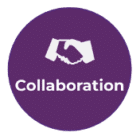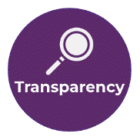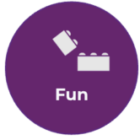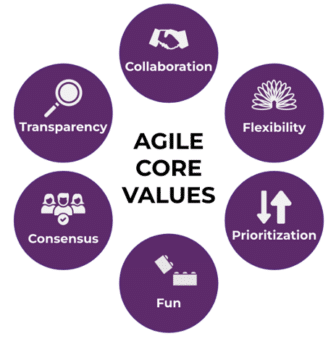Introduction
In Part I we discussed how to leverage Agile values to retain employees during the Great Resignation. Now let’s talk about turning the Great Resignation into an advantage. With 44% of the workforce looking for new opportunities, this is perhaps the best pool in decades from which to draw new talent. To be successful, you’ll need to embrace Agile values in your hiring process. As in Part I, we define Agility as a mindset expressed in a core set of values. Of particular focus in Part II are the values of collaboration, transparency, and fun. Sure, you can tell candidates about many of the great things about your company that we describe in Part I, but why not show them too?
Collaboration
 Inevitably, job candidates will ask about your company culture; you should be prepared to highlight the ways your organization collaborates. At EK, most of our internal initiatives are driven by small groups collectively working through ideas and details using virtual whiteboards and collaborative document creation. For example, we have several Communities of Practice formed from the bottom up where we address relevant topics. No one person “owns” these CoPs; instead, ideas are discussed, and an approach is collectively agreed to. Additionally, blogs such as this one are written, critiqued, and edited using Google Docs in real-time. This enables collaborative discussions, which would be slower and more difficult in traditional, waterfall publication pipelines. It’s also worth noting that collaboration often leads to consensus, another core Agile value. Together, these characteristics lead to a greater sense of ownership and job satisfaction. When interviewing candidates, discuss collaborative opportunities where your candidates might enjoy contributing in a non-hierarchical manner.
Inevitably, job candidates will ask about your company culture; you should be prepared to highlight the ways your organization collaborates. At EK, most of our internal initiatives are driven by small groups collectively working through ideas and details using virtual whiteboards and collaborative document creation. For example, we have several Communities of Practice formed from the bottom up where we address relevant topics. No one person “owns” these CoPs; instead, ideas are discussed, and an approach is collectively agreed to. Additionally, blogs such as this one are written, critiqued, and edited using Google Docs in real-time. This enables collaborative discussions, which would be slower and more difficult in traditional, waterfall publication pipelines. It’s also worth noting that collaboration often leads to consensus, another core Agile value. Together, these characteristics lead to a greater sense of ownership and job satisfaction. When interviewing candidates, discuss collaborative opportunities where your candidates might enjoy contributing in a non-hierarchical manner.
Secondly, don’t just tell candidates about how collaborative you are; show them. At Enterprise Knowledge (EK), many of our roles require strong facilitation skills. Therefore, one of our commonly used interview formats requires the candidate to facilitate a discussion with a role-playing product team in a real-world scenario. Our facilitation interviews aren’t designed with tricks and traps; rather, our interviewers actively seek to produce a collaborative artifact by the end of the discussion. The best candidates shine in a setting where they are able to effectively collaborate with strangers, and after being hired have often mentioned their positive experience getting a feel for how they will work with their future colleagues.
Transparency
 Transparency throughout the hiring process is crucial to attracting talent. You can achieve Agile transparency in hiring by properly setting interview expectations and clearly communicating the interview timeline.
Transparency throughout the hiring process is crucial to attracting talent. You can achieve Agile transparency in hiring by properly setting interview expectations and clearly communicating the interview timeline.
For example, in the above collaborative facilitation interview scenario, EK provides detailed instructions as to what’s expected and specifically what is not expected (e.g. independent preparatory research on the topic, a single “correct” answer, nor a client-ready artifact). Candidates should also be kept abreast of where they currently stand in the process. If you’re still sourcing more applicants, tell them. If the process is going to take several weeks or the timeline is unknown, tell them. And if a candidate is removed from selection, tell them in a timely manner. A company’s hiring process speaks volumes about its character, and transparency is perhaps the most critical element to a positive experience.
Fun
 Not all work is fun, but that doesn’t mean you shouldn’t look for opportunities to inject some excitement into what might otherwise be a monotonous process. In that vein, interviews can also be fun. At EK, we’ve used games like Catch Phrase and even group Lego building activities. It’s important to note that these aren’t just for the sake of fun. In addition to direct applicability to our work where we often incorporate games into the design/pilot phases of our change management strategy engagements, we’re assessing our candidates’ social interaction skills, which are critical for consultants. That said, feedback has shown that these activities are enjoyable for both candidates and interviewers alike.
Not all work is fun, but that doesn’t mean you shouldn’t look for opportunities to inject some excitement into what might otherwise be a monotonous process. In that vein, interviews can also be fun. At EK, we’ve used games like Catch Phrase and even group Lego building activities. It’s important to note that these aren’t just for the sake of fun. In addition to direct applicability to our work where we often incorporate games into the design/pilot phases of our change management strategy engagements, we’re assessing our candidates’ social interaction skills, which are critical for consultants. That said, feedback has shown that these activities are enjoyable for both candidates and interviewers alike.
Conclusion
Interviewing is a two-way process; candidates are interviewing you as well. Given that reality, the best way to attract talent is to show candidates your values rather than just talking about them. In particular, transparency, collaboration, and fun should be woven throughout your recruitment process. If you’re looking for help on how to instill these Agile values in your organization’s culture and undergo an Agile transformation in order to attract and retain top talent, our Agile consultants would love to hear from you!

